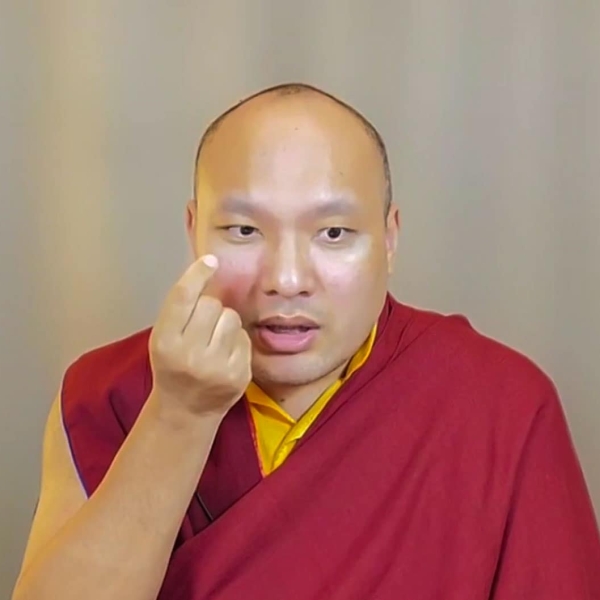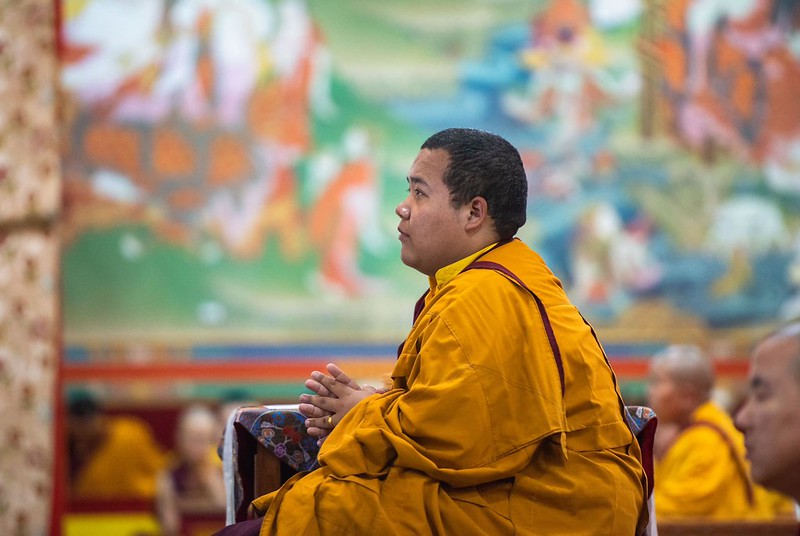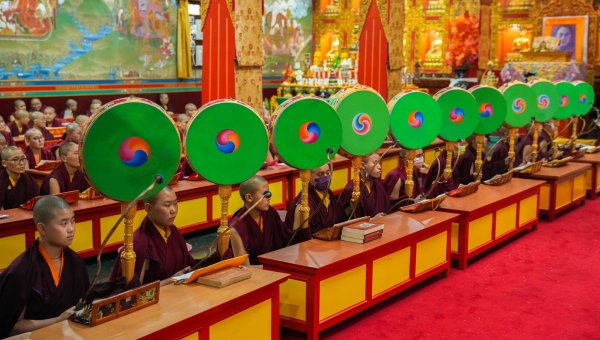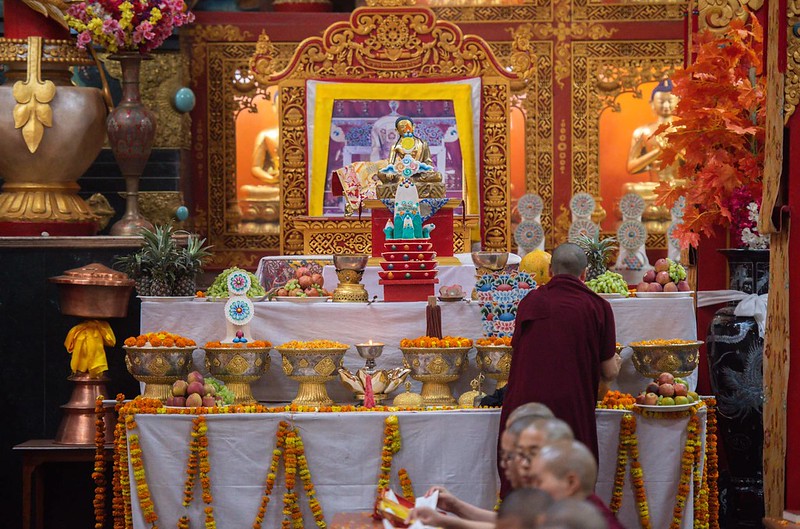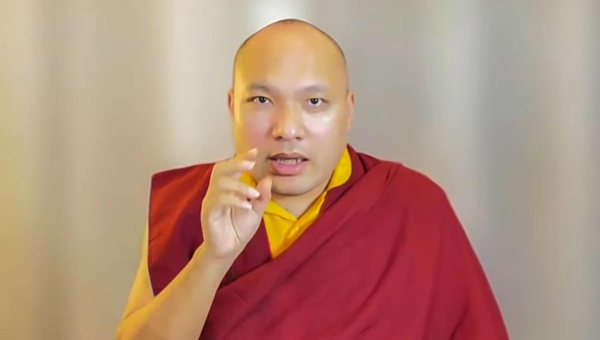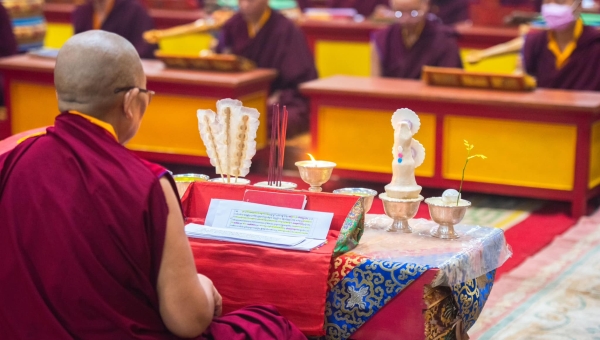Spring Teaching 2023 • Two Autobiographical Praises by Mikyö Dorje • Day 5
8 April 2023
This was the final day of the Spring Teachings to be given during the Arya Kshema. However, the teachings would continue until the Gyalwang Karmapa had completed his commentary on the texts. As summer approached in Varanasi, it would become intolerably hot, and therefore it was wiser for the nuns to disperse to their home nunneries as scheduled.
The focus was on Sangye Paldrup's commentary on verses 27 and 28 of the Good Deeds. These verses form parts two and three of the section on how Mikyö Dorje practised the path of the greater individual. They describe how he purified his own continuum and then aroused the intention to develop bodhichitta, meditated on the two types of bodhichitta, both aspiring and engaged, and trained in the precepts of the two types of bodhichitta.
How he trained in purifying his own continuumThe Gyalwang Karmapa paraphrased Sangye Paldrup's comments. First, Sangye Paldrup criticised all those lamas who do not live up to their name. These so-called lamas who are claimed to be unrivalled in getting others to serve the Three Jewels, bringing the defenceless to happiness, and teaching the path to excellence, should be able to recognise the difference between virtue and non-virtue. They are known as 'spiritual friends' and famed for bringing benefit to beings. However, in actuality, their title is an empty nomenclature. Once they have gained a certain status, they no longer teach with pure intention and even lead their followers astray. They teach them how to practise non-virtue rather than virtue. Part of the problem is that they themselves lack certainty in what constitutes non-virtue, and they are unable to see the faults of non-virtuous behaviour.
As long as you hang on to your intractable character,
You will not tame the mind streams of your followers.
So I focused on my own accumulation and purification
To increase accumulation and purification among my students.
I think of this as one of my good deeds. (27)
In contrast, Mikyö Dorje believed that in order to be able to tame sentient beings, he first needed to cleanse and tame his own mindstream.
Another fault of these lamas is to pay no attention to future lifetimes and only consider happiness and short-term benefits in this lifetime. They may have looked like they were performing Boddhisattva activities that benefitted others, but their short-term perspective turned their actions into pseudo-benefit and pseudo-Bodhisattva actions. Sangye Paldrup uses the simile: This is like a leper teaching a garuda sadhana. The Karmapa explained that leprosy is seen as a naga illness in traditional Tibetan medicine, and the antidote is a garuda sadhana. It would make no sense for a leper to teach a garuda sadhana because they wouldn't be a leper if they knew how to practice it correctly. Hence people would be suspicious of the leper. Likewise, it is impossible to tame other beings until you have tamed your own mindstream.
Furthermore, Mikyö Dorje understood the critical point that "in order to bring vast benefit to other sentient beings, and to practice true dharma, if you wish to do that, then it's essential to think about the next and future lives." He could clearly teach what people should and should not do because he practised this and gained experience and certainty. He had an excellent understanding of the main point of the dharma he was teaching. Once he had understood the main point, he was not satisfied with a mere understanding, but he put it into practice and developed experience. Because he then had absolute certainty in this dharma, he was able to teach others effectively.
The Karmapa warned that too many teachers lack even a basic idea of the main point of the dharma, let alone put it into practice. They are overconfident. They give empowerments, transmissions, teachings, and organise retreats, but in actuality in their own lives, they have not developed any experience or even a partial understanding of the dharma. They receive many offerings, count the number of their students, see the respect they receive, and so on, but they fail to examine whether there is quality or not in the result of their teachings and empowerments. Has it changed the students? Have the students internalised the teachings? Has it benefitted them? This is the true yardstick of success as a dharma teacher.
Lord Gampopa predicted:
In the future, when gurus have no experience and students no devotion, when they just give instructions as transmissions, my teachings will disappear.The Karmapa commented that in this situation, you have a lama who has no practice of the dharma and thus no experience or realisation of the dharma, and the students have no faith and devotion in the dharma or the lama, but still the lama pretends to be giving instructions and giving transmissions. That would be a sign that the Dakpo Kagyu teachings have disappeared.
The converse is a lama who has experience of the teachings and has incorporated them into their being. Then, you will have the guru with the blessings and the students with devotion, and the dharma will be good in the beginning, good in the middle, and good in the end; that is the sign that the actual teachings of the Dakpo Kagyu are still extant.
Dusum Khyenpa, Pakmodrupa, Gotsangpa and their disciples said precisely the same. In the words of Gotsangpa:
I have never taught anyone even a single word of dharma that I have not practised and gained experience in myself.This shows that they taught experiential dharma, not dry words; Mikyö Dorje repeatedly told others that this was the only way to teach the dharma. He taught the dharma that he had practised himself until he had developed experience and understanding and had the confidence that it would benefit his students in this and future lifetimes. For this reason, his students considered every single word of his teachings or advice extremely important. He set his students to practice accumulation and purification in order to make them receptive to the dharma, but he himself also worked hard at these practices in order to be of benefit to beings. He was a powerful model for his students and demonstrated his great devotion to the Three Jewels in all his activities, such as prostrations or making a mandala offering. This had a powerful influence on them. Mikyö Dorje advised that the greatest concern for lamas should be whether they could tame their students' afflictions and make their minds supple or not. Worrying about a student's everyday welfare and happiness in this lifetime was not the work of the lama.
The student's response should be to trust themselves fully to the lama and have the confidence that this is someone who can be a lasting refuge and hope for this and future lifetimes, who can give them direction in this and future lives. Without that perspective, the student is not a real student, no matter how many offerings they make to the lama or how many teachings, empowerments or transmissions they receive.
The Karmapa reminded everyone that in order for it to be true dharma, "it has to be for the sake of the next and future lifetimes."
Mikyö Dorje had no attachment to sensory pleasures. He was never distracted by diversions and so forth. He had no interest in the concerns of the world. He never tried to fool or deceive other people. He never acted like a charlatan. It just naturally occurred, it just naturally stopped. Likewise, he never lied about superhuman qualities or mistaken dharma. If he made a mistake, he admitted the fault. He would confess the fault and express regret. The Karmapa cited the example of how Mikyö Dorje admitted that some of his debate positions and refutations had been wrong. He confessed this directly and clearly without resorting to eloquence to obfuscate. His actions were sometimes criticised and misunderstood. He would not teach an area of dharma unless he had developed an understanding and realisation of it, and this was misinterpreted as showing a limited education in and lack of knowledge of the dharma. He would only teach the profound dharma and give empowerments to those with sufficient merit; his critics claimed this demonstrated his lack of training and inability to give instructions and empowerments.
Yet, for those fortunate ones who became his students, even a single word could inspire them with the wish for liberation from samsara and faith in the Three Jewels. They would know how to carefully choose what to do in karmic cause and effect, how to train in bodhichitta, and the training of the paths and levels. He would inspire them with the confidence that he was someone they could trust, someone who could show them the path to Buddhahood. Many developed this certainty.
Mikyö Dorje showed genuine affection and compassion towards his students. When people put their hopes in him, whether for dharma or for material things, without deceit or guile, he would treat them well and do as much as he could for them.
Even when he went to bed, he would be thinking of how to benefit other sentient beings: teaching dharma to those who requested dharma or fulfilling the needs of those who wanted material things such as food and clothing. Some came to him pretending to want dharma and asked for transmissions, empowerments and so forth when their real motivation was to gain kudos by receiving these from a high lama. In that case, he would try to mollify them but would limit what he gave. If, on the other hand, he encountered someone who really wanted to practise dharma from the bottom of their heart or who had the potential to become a good practitioner in future, he would pay them a lot of attention, spend time with them and do his best to nurture them. Sometimes he could be very informal with them, just talking and joking, but always with the aim of using different methods to benefit them and improve their minds.
How he trained in the ways of all bodhisattvasThe Karmapa then moved on to verse 28. He explained that 'to train in the ways of all bodhisattvas' entailed taking their conduct and behaviour as the model and striving to do the same:
Therefore, since all the activities of entering
The ways of enlightenment are inconceivable,
I made the prayer to follow in harmony
With the deeds of all the bodhisattvas.
I think of this as one of my good deeds. (28)
According to Mikyö Dorje's Instructions in Training in the Namthar, in order to tame others' beings, you first have to tame your own being.
In order to cleanse and purify others' mindstreams, you have to cleanse and improve your own mind. You need to recognise what your faults are, recognise them as faults, and recognise your qualities as qualities.
For faults, you need to do whatever you can to decrease them.
For qualities, you need to do whatever you can to increase them.
That's what you should do.
However, when it comes to the faults and qualities of other beings, we must be wary.
We see other people's faults but fail to see our own. We blame other people for their mistakes but never acknowledge and take responsibility for the ones we make. Instead, we consider ourselves as having qualities and never making mistakes. The Karmapa highlighted how dangerous this attitude is, particularly as we do not understand how great bodhisattvas act to benefit beings. We might unwittingly criticise a bodhisattva because of our wrong views. If we do, we will destroy all the roots of virtue we have accumulated. Until we have the clairvoyance of telepathy, when we can really understand a person's thinking, aims and motivation, we are mistakenly holding our five senses to be authoritative and judging by external appearances. There are many times when these five senses are not reliable sources of information. Consequently, we should only concentrate on our own faults and always try to see the qualities in others. We should consider that all sentient beings have buddha nature, and that is sacred. They are precious and an inexhaustible source of qualities.
In One Hundred Short Instructions, Mikyö Dorje repeats this advice.
Do not speak about worldly faults, such as being disabled or dharma faults, such as violations of discipline. In brief, do not think anything about others' faults. If you see a fault in someone else, you must pray fervently that no such fault should reoccur and that you may never see that fault in the future. In brief, you must purify whichever affliction is strongest in your being. When asked what your greatest affliction is, you should tell your guru. The guru should also teach all dharma as the antidote for it. For example, just as when in the world, you sometimes have to go to war. No matter how you are going to fight, you must surround them with your forces on the outside and get them to revolt internally. Similarly, when practising dharma, on the outside you must attack the affliction with the armies of the Kagyu gurus and the dharma, and on the inside, you must stir up the revolt of the antidote within the students' mindstreams. You must do what you can to get the dharma to arise through determination, devotion, and diligence in their beings.The Karmapa explained that in the same way that we should not disparage someone with a disability, we should not disparage those with dharma faults such as breaches of discipline. Instead, we should make the aspiration that the person never commits that fault again and that we never see such faults in future.
When we see a fault in another person, it is because of our karmic connections with that person, our karmic imprints, our afflictions and our confusion; others may not see that same fault. The Karmapa compared it to how a hundred people looking at the colour blue will each see it differently. Buddhas and bodhisattvas who have exhausted their karma and afflictions do not see others negatively as we do. So, when we see something negative in another being, there may be a fault, but at that same time, it is also a fault in ourselves. This is the reason we should pray not to see that fault again.
As practitioners, we must first work to eliminate our most dominant affliction. We should not try to conceal it from our lama; we should be totally open with our teacher. Then they can teach us the dharma we need and effective antidotes.
Mikyö Dorje compares the battle to overcome the afflictions with strategies in warfare. It's a two-pronged attack. One force attacks from the outside while the other works within, fomenting rebellion and destabilising the country. The external force is the gurus and the dharma. Internally, we need to have a rebellion in our mindstream which recognises the affliction as a negative rather than positive quality. Combining the two together gives us the power to overcome the affliction.
Some people raise objections: Seeing something good as bad is indeed wrong. But if the fault you see is definitely a fault, isn't it wrong not to point it out?
The Karmapa explained that there are people who have committed many mistakes but we have to be able to distinguish the individual from their mistakes. They will also have accumulated good deeds, so it would be wrong to denigrate them. This would be a form of disrespect. It would be like the action of destroying a clay buddha image. Of course, the image is not the buddha's kaya, but it's said that by destroying the clay image, you incur the misdeed of destroying the non-composite kaya of a buddha.
It is extremely difficult without clairvoyance to know the outcome of what we perceive as positive or negative deeds. Sometimes, in the world, when a good person performs what seems to us a terribly bad action, it can become beneficial to sentient beings. When a bad person does something good, it can become the karma for destroying the Buddha's teachings. It is very difficult for us to determine quickly whether something is good or bad. And if the person committing the action is a bodhisattva, if we feel hatred and anger towards them, and criticise them, we incur a huge misdeed.
A passage in the Noble Mahayana Sutra Called Entering the Seal of Determinate and Indeterminate Beings states:
Manjushri, compared to a son or daughter of noble family who gouged out the eyes of all sentient beings in the worlds of the ten directions, a son or daughter of noble family who was angered and looked at a bodhisattva with a malicious mind would produce an incalculably greater misdeed."We need to be very careful," the Karmapa warned." We don't know who is a bodhisattva, so it's possible that there's a bodhisattva among the ants. It's possible that there are bodhisattvas among cats and dogs. It's not necessary that a bodhisattva be human, so we shouldn't look at any being in negative terms." He continued, "If we can, we should try to make good, virtuous connections with them; otherwise, if we are unable to make a good connection, we should at the least suspend judgement. In terms of attachment and aversion, it is not good to develop bias."
In the words of the Kadampa master, Geshe Neu Zurpa:
These days everyone says they have run out of dharma to practice and do whatever they can do to get all the dharma they can. But among them, they do not think, "I’ve gained experience of this practice, I haven’t of that one.” Among them, I haven’t ever seen any who, at the same time as they say verbally “I go for refuge to the Three Jewels,” do not criticise the khenpos, teachers, sangha, and so forth whom they ask for refuge.The Karmapa commented that people were getting as many dharma teachings as possible, asking for transmissions and empowerments, but never practising them, as if, once the lama had placed the vase on their head, that was sufficient. Actually, when the lama gives an empowerment, a teaching or a transmission, we need to practise it. If we don’t practise, no matter how many empowerments or teachings or transmissions we receive, they are all empty and go to waste. Moreover, people were going for refuge and then being critical of those who had given them refuge—the sangha, the lamas, the khenpos and so forth. What they said was condemning them to hell, so it would be better for their lips to be completely sealed except at mealtimes.
These poisonous lips will themselves cast us into hell. If someone cared for me, they would put a lock on these lips, give the key to someone else, and only open them when I ate or drank.

















